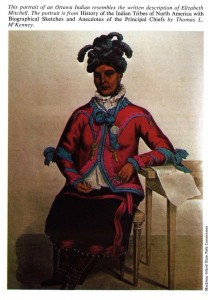Guest post by Elizabeth Mason
From an early age I was intrigued by the story my grandmother told me about her grandmother, an Indian woman who ran the Mackinac Company. Besides, I was named after this woman — Elizabeth. And when in my late teens I learned there was information about her in a book my mother had, Fred Landon’s Lake Huron, I was hooked.
For the next forty-odd years I collected books, pamphlets, maps, pictures, everything I could get my hands on related to Elizabeth Mitchell (née Bertrand). I corresponded with researchers and distant relatives of my ancestors in Arkansas, Kansas, Montreal, Michilimackinac.
My grandmother, my mother, and I took a road trip to Mackinac Island. We met a woman who remembered where Elizabeth’s house had been and we took a picture of it. We visited the fort where Elizabeth’s husband, a graduate in medicine from the University of Edinburgh, was once surgeon’s mate in the 8th King’s (Liverpool) Regiment, and we were shown Elizabeth’s tombstone, moved for safety from the cemetery of St. Anne’s Church below the fort.
The story became more and more fascinating as I learned that here was a woman who ran a massive fur trade company, once the largest in North America, the influence of which stretched all the way from Montreal to the Mississippi and from Michilimackinac down Lake Michigan to the St. Joseph River. This was a heroic woman whose story had profound implications for the history of Canada. Yet she was never talked about.
Now what was I to do with all this?
My husband suggested I give a paper at the Fourth North American Fur Trade Conference in October 1981. My speech created some interest but was not included in the papers published in book form because “there was no one with the expertise to vet it.” I gave one more paper, jointly with another Indian scholar, at the Fifth Fur Trade Conference in Montreal, but I was becoming discouraged.
Meanwhile a friend in Women’s Studies at the Toronto Board of Education spoke to a colleague at OISE about my work, and one day I got a phone call from TVO asking if I would be willing to do a research paper for a half-hour French program about “Elizabeth” as part of its series Témoins du Passé, which was to include Etienne Brûlé, the Head of the Grey Nuns, J.A.S. Plouffe, Oliva Dionne, and eight others. The program about Elizabeth was a great success, though I was sad it was not shown in English as well.
Soon after that I went back to teaching, half hoping someone else would take up the cause. There were lots of leads out there for another researcher-writer to pick up on and I was tired of it all.
It wasn’t until I retired thirteen years later that I realized something: no one else was going to write this book. I would have to write it. And I decided that, lacking a PhD in history, I would have to make it a historical novel.
I’ve never regretted that decision. It allowed me more flexibility, and having the characters actually talk to each other and disagree about important matters added a new dimension to the historical events. Of course, it was challenging to merge fact and fiction and in the process make the characters come alive. At first the historical facts often overwhelmed the story. Each time, my editors made me aware of this and it was back to the drawing board. The manuscript, now 400 pages, has been substantially edited and undergone numerous rewritings. Sometimes I find it is best to go back to your original draft, but in general the book improves each time you go over it. Even John Milton rewrote his manuscripts more than once.
Sometimes revising means finding new material to expand a section; other times changes are more straightforward. I make lots of spelling errors — I never could spell very well — and often have to look up words in the dictionary. I find this revising enjoyable on the whole. It’s not like the terror of dealing with a blank page.
This book has taken me over ten years to write, not counting a lifetime of research, corresponding with interesting people, and having the privilege of working, consecutively, with not one but two fantastic editors. I’ve hardly ever disagreed with either one of them. More than anything, researching and writing about the fascinating life of Elizabeth Bertrand has made me realize that what happens in the world, good and bad, has very little to do with religion, politics, country of origin, race, sex, et cetera. It has everything to do with the character of the individuals involved.
♦ ♦ ♦
ELIZABETH MASON is a former teacher. She lived for eight years in London, England, where she did post-graduate work in English at King’s College, University of London, and taught in a Secondary Modern School. Returning to Toronto she became involved in the Native Community, as a Liaison Volunteer for the Toronto Board of Education, as a Board Member at Anduhyaun, and as a teacher at the First Nations School.
This essay was originally published on this website in August 2010.

How do I obtain a copy of Elizabeth Mason’s “Of Eloquent Blood”? Elizabeth Mitchell is also my ancestor. I would love more information about her .
Thank you!